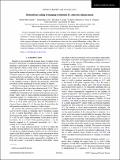| dc.contributor.author | McConnell, Robert | |
| dc.contributor.author | Bruzewicz, Colin D. | |
| dc.contributor.author | Chiaverini, John | |
| dc.contributor.author | Sage, Jeremy M. | |
| dc.contributor.author | Low, Guang Hao | |
| dc.contributor.author | Yoder, Theodore James | |
| dc.contributor.author | Chuang, Isaac | |
| dc.date.accessioned | 2017-12-28T18:16:23Z | |
| dc.date.available | 2017-12-28T18:16:23Z | |
| dc.date.issued | 2017-11 | |
| dc.date.submitted | 2016-06 | |
| dc.identifier.issn | 2469-9926 | |
| dc.identifier.issn | 2469-9934 | |
| dc.identifier.uri | http://hdl.handle.net/1721.1/112956 | |
| dc.description.abstract | Classical imaging works by scattering photons from an object to be imaged, and achieves resolution scaling as 1/√t, with t the imaging time. By contrast, the laws of quantum mechanics allow one to utilize quantum coherence to obtain imaging resolution that can scale as quickly as 1/t – the so-called “Heisenberg limit.” However, ambiguities in the obtained signal often preclude taking full advantage of this quantum enhancement, while imaging techniques designed to be unambiguous often lose this optimal Heisenberg scaling. Here we demonstrate an imaging technique which combines unambiguous detection of the target with Heisenberg scaling of the resolution. We also demonstrate a binary search algorithm which can efficiently locate a coherent target using the technique, resolving a target trapped ion to within 0.3% of the 1/e² diameter of the excitation beam. | en_US |
| dc.description.sponsorship | United States. Air Force Office of Scientific Research (Contract FA8721-05-C-0002) | en_US |
| dc.publisher | American Physical Society | en_US |
| dc.relation.isversionof | http://dx.doi.org/10.1103/PhysRevA.96.051801 | en_US |
| dc.rights | Article is made available in accordance with the publisher's policy and may be subject to US copyright law. Please refer to the publisher's site for terms of use. | en_US |
| dc.source | American Physical Society | en_US |
| dc.title | Heisenberg scaling of imaging resolution by coherent enhancement | en_US |
| dc.type | Article | en_US |
| dc.identifier.citation | McConnell, Robert et al. "Heisenberg scaling of imaging resolution by coherent enhancement." Physical Review A 96, 5 (November 2017): 051801(R) © 2017 American Physical Society | en_US |
| dc.contributor.department | Massachusetts Institute of Technology. Department of Physics | en_US |
| dc.contributor.mitauthor | Low, Guang Hao | |
| dc.contributor.mitauthor | Yoder, Theodore James | |
| dc.contributor.mitauthor | Chuang, Isaac | |
| dc.relation.journal | Physical Review A | en_US |
| dc.eprint.version | Final published version | en_US |
| dc.type.uri | http://purl.org/eprint/type/JournalArticle | en_US |
| eprint.status | http://purl.org/eprint/status/PeerReviewed | en_US |
| dc.date.updated | 2017-11-14T22:10:13Z | |
| dc.language.rfc3066 | en | |
| dc.rights.holder | American Physical Society | |
| dspace.orderedauthors | McConnell, Robert; Low, Guang Hao; Yoder, Theodore J.; Bruzewicz, Colin D.; Chuang, Isaac L.; Chiaverini, John; Sage, Jeremy M. | en_US |
| dspace.embargo.terms | N | en_US |
| dc.identifier.orcid | https://orcid.org/0000-0002-6211-982X | |
| dc.identifier.orcid | https://orcid.org/0000-0001-9614-2836 | |
| dc.identifier.orcid | https://orcid.org/0000-0001-7296-523X | |
| mit.license | PUBLISHER_POLICY | en_US |
| mit.metadata.status | Complete | |
